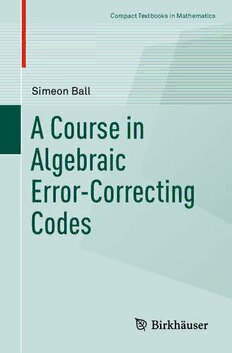
A Course in Algebraic Error-Correcting Codes PDF
Preview A Course in Algebraic Error-Correcting Codes
Compact Textbooks in Mathematics Simeon Ball A Course in Algebraic Error-Correcting Codes CompactTextbooksinMathematics CompactTextbooksinMathematics This textbook series presents concise introductions to current topics in math- ematics and mainly addresses advanced undergraduates and master students. Theconceptistooffersmallbookscoveringsubjectmatterequivalentto2-or3- hourlecturesorseminarswhicharealsosuitableforself-study.Thebooksprovide studentsandteacherswithnewperspectivesandnovelapproaches.Theymay featureexamplesandexercisestoillustratekeyconceptsandapplicationsofthe theoreticalcontents.Theseriesalsoincludestextbooksspecificallyspeakingto theneedsofstudentsfromotherdisciplinessuchasphysics,computerscience, engineering,lifesciences,finance. • compact:smallbookspresentingtherelevantknowledge • learningmadeeasy:examplesandexercisesillustratetheapplicationofthe contents • usefulforlecturers:eachtitlecanserveasbasisandguidelineforasemester course/lecture/seminarof2–3hoursperweek. Moreinformationaboutthisseriesathttp://www.springer.com/series/11225 SimeonBall A Course in Algebraic Error-Correcting Codes SimeonBall DepartmentofMathematics PolytechnicUniversityofCatalonia Barcelona,Spain ISSN2296-4568 ISSN2296-455X (electronic) CompactTextbooksinMathematics ISBN978-3-030-41152-7 ISBN978-3-030-41153-4 (eBook) https://doi.org/10.1007/978-3-030-41153-4 MathematicsSubjectClassification(2010):94BXX,51EXX,94AXX ©SpringerNatureSwitzerlandAG2020 Thisworkissubjecttocopyright.AllrightsarereservedbythePublisher,whetherthewhole orpartofthematerialisconcerned,specificallytherightsoftranslation,reprinting,reuse ofillustrations,recitation,broadcasting,reproductiononmicrofilmsorinanyotherphysical way,andtransmissionorinformationstorageandretrieval,electronicadaptation,computer software,orbysimilarordissimilarmethodologynowknownorhereafterdeveloped. Theuseofgeneraldescriptivenames,registerednames,trademarks,servicemarks,etc.inthis publicationdoesnotimply,evenintheabsenceofaspecificstatement,thatsuchnamesare exemptfromtherelevantprotectivelawsandregulationsandthereforefreeforgeneraluse. Thepublisher,theauthorsandtheeditorsaresafetoassumethattheadviceandinformation inthisbookarebelievedtobetrueandaccurateatthedateofpublication.Neitherthe publishernortheauthorsortheeditorsgiveawarranty,expressedorimplied,withrespect tothematerialcontainedhereinorforanyerrorsoromissionsthatmayhavebeenmade. Thepublisherremainsneutralwithregardtojurisdictionalclaimsinpublishedmapsand institutionalaffiliations. ThisbookispublishedundertheimprintBirkhäuser,www.birkhauser-science.combythe registeredcompanySpringerNatureSwitzerlandAG Theregisteredcompanyaddressis:Gewerbestrasse11,6330Cham,Switzerland v Preface This book is based on lecture notes for a course on coding theory given aspartoftheAppliedMathematicsandMathematicalEngineeringmaster’s degreeattheUniversitatPolitécnicadeCatalunya.Theaimofthecourseis togiveanup-to-dateaccountoferror-correctingcodesfromamathematical point of view, an analysis of the construction of these codes, and of the variousalgorithmswhichareimplementedtocorrectcorruptedmessages. Thelectureswerepreparedforanaudienceatmaster’slevel,althougha largeproportionofthebookshouldbeaccessibletostudentsatundergradu- atelevelandtoengineeringandphysicsstudentstoo.Thereissomeformal algebrathatmaynotbefamiliar,mainlyintheintroductionoffinitefieldsin Chapter2,butthisisnotessentialtobeabletofollowthemainpartofthe content.Itisenoughtoknowhowtoperformfinitefieldarithmeticandhow tofactorisepolynomialsoverfinitefields,allofwhichareexplainedindetail inChapter2. A large part of the material includedin the text dates backto the latter part of the last century. However, there have been recent advances in the algebraictheoryoferror-correctingcodes,manyofwhichareincludedhere. There are still questions and problems which remain unresolved despite considerable effort having been directed towards their resolution. Many of thesearehighlightedinthetext.Thebooktakesacombinatorial,algebraic, and geometric view of coding theory but combines this with a practical considerationofhowthecodesconstructedareimplemented. Shannon’s theorem, the highlight of Chapter 1 and which dates back to 1947, tells us that given a noisy, not totally unreliable, communication channel,therearecodeswhichprovideameansofreliablecommunication at a transmission rate arbitrarily close to the capacity.However,Shannon’s theorem only tells us that reliable communication is possible, it does not provideuswithafeasiblewayinwhichtoencodeordecodethetransmission. Oneoftheaimsofthebookistofindcodeswithahightransmissionrate, whichallowfastencodinganddecoding.Onthewaytowardsthisobjective, we construct various types of codes and consider a number of decoding algorithms. Chapter 2 is a brief introduction to finite fields and the geometries associated with these fields. An emphasis is given to the factorisation of cyclotomicpolynomialsoverfinitefields,whichisputtouseinChapter5. The concept of a minimum distance between any two codewords of a blockcodeisintroducedinChapter3.Thelargertheminimumdistance,the moreerrorsonecancorrectand,togetherwiththelengthandsizeofthecode, are the fundamental parameters of a block code. There are various bounds on these parameters proven in Chapter 3, both the Gilbert–Varshamov lower bound, given by the greedy algorithm, and upper bounds, a discrete vi Preface sphere-packing bound and the better Plotkin and Elias-Bassalygo bounds. ThecodesgivenbytheGilbert–Varshamovboundareasymptoticallygood codesinthesensethatboththetransmissionrate,theproportionofthebitsof themessagewhichcontainsinformation,andtherelativeminimumdistance are boundedaway from zeroas the lengthof the codeincreases.However, inpractice,asinthecaseoftherandomlychosencode,thereisnoefficient wayinwhichtoencodeordecodethemessageusingthesecodes. Theadvantageoflinearcodes,thefocusofChapter4andfundamental tomostoftherestofthebook,isthattheyareefficienttoencode.Onecan encodebysimplymultiplyingavectorbyamatrix.Weconsideradecoding algorithm for linear codes based on syndromes. The question of existence of a vector of small weight with a specified syndrome is shown to be NP- complete,whichimpliesthatthedecodingalgorithmisnotfeasibleforlong codes,althoughitisusedinpracticeforshortlengthcodes. The classical 2-error correcting and 3-error correcting perfect codes are constructed in Chapter 5, as well as the general class of BCH codes. Although BCH codes exist for all lengths, it is known that there are no sequences of BCH codes for which the transmission rate and the relative minimumdistancearebothboundedawayfromzero. Reed–Solomoncodesarecodeswhosecodewordsaretheevaluationof polynomials of low degree. In Chapter 6, we will exploit this algebraic structure to explicitly develop a polynomial time decoding algorithm for Reed–Solomoncodeswhichwillcorrectanyerrorbits,providingthenumber of errors is less than half the minimum distance. We will also show that there is a polynomial time list decoding algorithm which produces a short list of possible candidates for the sent codeword when far more errors occur. By employing two Reed–Solomon codes, this allows one to decode correctlywellbeyondthehalftheminimumdistanceboundwithveryhigh probability.AnotherimportantapplicationofMDScodes,andinparticular Reed–Solomoncodes,isthestorageofdataindistributedstoragesystems. The fact that the codewords of an MDS code are uniquely determined by relatively few bits means that data, stored across a number of different servers,canberecoveredfromjustafew. In Chapter 7 we prove that there are subfield subcodes of generalised Reed–Solomon codes meeting the Gilbert–Varshamov bound. Since these codes are linear, they are fast to encode and the fact that they have an algebraic structure allows us to decode using the list decoding algorithm fromChapter6.Wethengoontoconsidercodesconstructedfromalgebraic curves. These algebraic-geometric codes include codes which surpass the Gilbert–Varshamovboundforcodesoverlargealphabets. Therearelinearcodesconstructedfromlow-densityparitycheckmatri- cesforwhichboththetransmissionrateandtherelativeminimumdistance areboundedawayfromzero.WewillproveinChapter8thatwecanencode and decode certain low-density parity check codes with polynomial time vii Preface algorithms.Thesecodesarewidelyimplementedinwirelesscommunication, withatransmissionrateclosetothecapacitysetoutbyShannon’stheorem. Although not asymptotically good, Reed–Muller codes and their sub- codes, the theme of Chapter 9, are widely implemented since there are fastdecodingalgorithmsforthesecodes,suchasamajoritylogicdecoding algorithmwhichisdetailedhere.Kerdockcodesarecertainsubcodesofthe second-orderReed–Mullercodes.Theyareofparticularinterestsincethere areKerdockcodeswhicharenon-linearcodeswithparametersforwhichit isknownthatnolinearcodeexists. Bringing together p-adic numbers and cyclic codes in Chapter 10, we constructnon-linearcodeswhicharelinearovertheringofintegersmodulo a prime power. Within this class of codes we again construct a non-linear binary code with parameters for which it is known no binary linear code exists.Thissuggeststhat,moregenerally,thesecodescouldbeasourceof codeswhichperformbetterthanlinearcodes. The three main conjectures concerning error-correcting codes are included.TheInformationTheoryandApplicationsCenteroftheUniversity of California San Diego offers prizes for the resolution of any of these threeconjectures.Thethreeconjecturescanberoughlystatedas,thereisno infinitesequenceofbinarycodesbetterthantheGilbert–Varshamovbound, there are no non-trivial constant weight perfect codes, and there are no linear MDS codes longer than the Reed–Solomon codes, apart from some three-dimensionalevencharacteristiccodesandtheirduals. I would like to thank Tim Alderson, Anurag Bishnoi, Aart Blokhuis, Massimo Giulietti, Victor Hernandez, Michel Lavrauw, Sonia Mansilla, ValentinaPepe,andOriolSerrafortheircommentsandsuggestions.Iwould alsoliketothankFrancescComellasfordrawingsomeofthefigures. Barcelona,Spain SimeonBall October2019 viii Preface Thedependenciesbetweenthechaptersareasfollows. ix Table of Parameters for Codes in the Text Thefollowingtableliststheparametersofthespecificcodesconstructedin the text. An [n,k,d] code refers to a k-dimensional linear code over F q q oflengthnandminimumdistanced.A(n,K,d) codereferstoacodeof r lengthn,sizeK,andminimumdistanced overanalphabetofsizer. Parameters Name Example3.4 (6,8,3)2 Example3.6 (7,8,4)2 Example3.11 (6,4,4)2 Exercise3.2 (7,16,3)2 Exercise3.4 (10,6,6)2 Exercise3.5 (6,4,5)3 Example4.2 [7,4,3]2 BinaryHamming Example4.3 [9,3,6]3 Example4.5 [(qm−1)/(q−1),(qm−1)/(q−1)−m,3]q Hamming Example4.8 [8,4,4]3 √ √ √ Example4.16 [q q+1,3,q q− q]q Hermitiancurve Example4.19 [10,6,4]3 Example4.23 [10,4,6]3 Exercise4.7 [6,3,4]5 Exercise4.8 [7,3,5]7 Exercise4.9 [9,3,6]3 Exercise4.14 [10,6,4]3 Example5.5 [11,6,5]3 TernaryGolay Example5.5 [12,6,6]3 ExtendedternaryGolay Example5.9 [23,12,7]2 BinaryGolay Example5.9 [24,12,8]2 ExtendedbinaryGolay Example5.11 [31,16,7]2 Example5.12 [n,n−d+1,d]q CyclicReed–Solomon Exercise5.6 [15,7,5]2 Exercise5.6 [31,11,11]2 Exercise5.6 [13,4,7]3 Exercise5.7 [17,9,5]2 Zetterberg Exercise5.7 [18,9,6]2 ExtendedZetterberg Exercise5.8 [11,6,5]4 Exercise5.9 [17,9,7]4 (continued)
